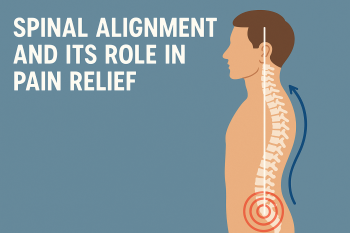
Mild traumatic brain injuries are also known as concussions. It's projected that these traumas have an incidence of 3.8 million each year in the United States. Despite this high incidence, moderate traumatic brain injuries and concussions are among the least understood accidents within sports healthcare and the neuroscience communities. The majority of patients sustaining a concussion have their symptoms resolve over 7--10 days. However, approximately 10--15% of these patients develop persistent symptomatology long-lasting weeks, months, or even years after injury. This chronic condition is known as post-concussion syndrome. The patient is considered to be chronic when symptoms persist more than 4-12 weeks. It's assumed that post-concussion syndrome manifests secondary to brain injury resulting in alterations in brain biochemistry, neurophysiology, and metabolism; the challenge is assumed to be in the brain. But, four lines of information challenge this premise:
First Line of Proof The standard therapy for mild traumatic brain injury and post-concussion syndrome is rest. This approach works well for 85-90 percent of patients, but maybe not for those suffering from post-concussion syndrome. This suggests that maybe an etiology aside from brain injury is responsible for the continuing symptomology.
Second Line of Proof There's a considerable overlap of these signs and symptoms of moderate traumatic brain injury and of whiplash-associated disorders. This might indicate the possibility that the post-concussion syndrome symptoms may in fact be originating from the cervical spine. Signs and Symptoms of Concussion and Symptoms of Whiplash Associated Disorders
- Pressure in Head
- Headache
- Neck pain
- Neck/shoulder pain
- Reduced/painful throat moves
- Nausea
- Vomiting
- Dizziness
- Balance problems
- Dizziness
- Unsteadiness
- Blurred Vision
- Sensitivity to moderate
- Vision issues
- Issue recalling
- Confusion
- Feeling Like "In a Fog"
- Difficulty Concentrating
- Memory problems
- Problems Concentrating
- Sensitivity to Noise
- Ringing in Ears
- Feeling Slowed Down
- "Don't Feel Right"
- Nervous / Anxious / Irritable
- Sadness / More Emotional
- Fatigue / Low Energy /Drowsiness
- Trouble Falling Asleep
- Reduced/painful Jaw Movements
- Numbness, Tingling or Pain in Arm or Hand
- Numbness, Tingling or Pain in Leg or Foot
- Difficulty Swallowing
- Lower back pain
Third Line of Proof There is a possibility that the forces necessary to cause a mild traumatic brain injury may also injure the soft tissues of the cervical spine. The range of linear impact accelerations resulting in concussion injury is between 60--160 G, together with the peak occurring at 96 G (5). Whiplash injuries can happen at accelerations of 4.5 G (6). Thus it's highly likely that individuals who experience the G forces to maintain a concussion may even undergo cervical spine injury. In 2015, Cameron Marshall DC, Howard Vernon DC, John Leddy MD, and Bradley Baldwin DC printed a post in The Physician and Sportsmedicine, branded:
The function of the Cervical Spine in Post Concussion Syndrome A proposed mechanism for persisting symptomatology following concussion (the post-concussion syndrome) is "concomitant low-grade sprain--strain injury of the cervical spine occurring simultaneously with significant head trauma."
"Any substantial blunt effect and/or acceleration/deceleration of the mind will also lead to a certain amount of inertial loading of the neck possibly resulting in pressure injuries to the soft tissues and joints of the spinal column."
"Acceleration/deceleration of the head-neck complex of sufficient size to induce mild traumatic brain injury can also be very likely to trigger irreparable harm to the joints and soft tissues of the spinal column." It is "well established that injury and/or dysfunction of the cervical spine may lead to numerous signs and symptoms synonymous with a concussion, including headaches, dizziness, in addition to cognitive and visual malfunction; making diagnosis difficult."
"The signs of headache and dizziness, so widespread in concussion-type injuries, may actually be the result of cervicogenic mechanisms because of a concomitant whiplash injury suffered at the exact same time." It seems improbable, if not impossible, such as the forces required to generate a mild traumatic brain injury not to also cause an injury to the delicate tissues of the cervical spine.
Fourth Line of Proof Anatomically and physiologically, the cervical spine is linked to the brain and brainstem. Numerous brain stem structures receive mono-synaptic inputs from the C2 dorsal root ganglion afferents, such as:
- Lateral cervical nucleus
- Central cervical nucleus
- Caudal projections to C5 degree
- Cuneate nucleus, lateral cuneate nucleus
- Nucleus tractus solitarius
- Intercalatus nucleus
- Nucleus X of the vestibular system
- Trigeminal-cervical nucleus (for aggravation nociception)
Cervicogenic headaches were recognized for decades. In 2006, researchers in the University of Guelph, Ontario, CAN publish a study in the journal Brain Injury, titled: Is there a relationship between whiplash-associated disorders and concussion in baseball? A preliminary research The authors analyzed the connection between the incidence of whiplash-associated ailments and concussion symptoms in hockey players.
The research design was prospective cohort observational research. Twenty hockey teams have been followed prospectively for a single season. Team therapists completed severe and 7-10 afternoon follow-up test questionnaires for all the players that received either a whiplash mechanism or a concussion. The authors found that basically all patients that received a whiplash-mechanism accident also sustained some degree of mild traumatic brain injury. Similarly, all patients that received a mild traumatic brain injury also showed signs of cervical spine injury.
The authors concluded: There's a strong association between induced neck injuries and the signs of concussion in baseball injuries." "Both ought to be assessed when dealing with athletes/patients suffering from either injury." In 2013, researchers at the University of Calgary, Calgary, Alberta, CAN publish a study in the Clinical Journal of Sports Medicine, titled: Preseason reports of neck pain, dizziness, and headache as risk factors for concussion in men youth hockey players
The goal of this research was to determine the risk of concussion in youth male hockey players with preseason reports of neck pain, headaches, or dizziness. The authors pooled data from two prospective cohort studies. A total of 3,832 male ice hockey players aged 11 to 14 years (280 teams) engaged. Participants recorded baseline preseason symptoms of dizziness, neck pain, and headaches on the Sports Concussion Assessment Tool. Concussions that occurred during the entire year were recorded using a validated prospective injury surveillance system. The findings were as follows:
- Preseason reports of neck pain and headache increased the risk of concussion.
- Preseason nausea raised the risk of concussion.
- A mixture of any two symptoms (neck pain, nausea, dizziness) increased the risk of concussion by 265%
Four studies have concluded that injuries of the cervical spine are responsible for post-concussion syndrome, and have shown excellent clinical outcomes as a result of therapy to the cervical spinal column. In 1990, researchers from the Department of Rheumatology, County Hospital of Aarhus, Denmark, published a study in the journal Cephalalgia, branded:
An open study comparing manual treatment with the use of cold packs in the treatment of post-traumatic aggravation The authors used 19 patients who had sustained head trauma and that we're still suffering from headaches one year after. These patients entered a potential clinical controlled trial to find out if specific manual treatment on the neck could lessen their headache.
Ten patients have been treated twice with manual neck treatment and nine patients had been treated twice with cold packs around the neck. The pain index was calculated. Two weeks after the last treatment the mean pain index was significantly decreased to 43% in the group treated with manual therapy compared with the pretreatment level. At follow-up five weeks after, the pain index was lower in this category compared with the group treated with cold packs.
The authors concluded: "Manual therapy employed in this study seems to have a particular effect in reducing post-traumatic headache." "The result supports the theory of a cervical mechanism causing post-traumatic headache and indicates that post-traumatic dizziness, visual disturbances, and ear ailments may be part of a cervical syndrome" In 1994, researchers in the Department of Physiotherapy, University of Queensland, Australia, published a study in the journal Cephalalgia, branded: Cervical musculoskeletal dysfunction in post-concussion headache.
The authors note, "persistent headache is a common symptom following a minor head injury or concussion, potentially linked to simultaneous harm of the structure of the cervical spine" This study quantified aspects of peripheral vascular function in a group of twelve patients with post-concussion headache and at a normal control group.
The post-concussion headache group was distinguished from the control group from the presence of painful upper cervical segmental joint dysfunction, less endurance in the neck flexor muscles along a higher prevalence of reasonably tight throat musculature.
The authors concluded: "As upper cervical joint dysfunction is a feature of cervicogenic causes of aggravation, the results of the study encourage the addition of a precise physical examination of the cervical region in the differential diagnosis of patients afflicted persistent headache after a concussion." In 2014, researchers from the University of Calgary, Alberta, CAN, and the University of British Columbia, Vancouver, British Columbia, CAN publish a study in the British Journal of Sports Medicine:
Cervico-vestibular rehabilitation in sport-related concussion: A randomized controlled trial These authors note "concussion is a common injury in sports. Most individuals recover in 7-10 days but a few have persistent symptoms. The target of this research was to determine if a mix of vestibular rehabilitation and cervical spine physiotherapy diminished time until medical clearance in individuals with prolonged post-concussion symptoms." This study was a randomized controlled trial. Consecutive patients with persistent symptoms of dizziness, neck pain, or pain following a sport-related concussion (12-30 decades, 18 male and 13 female) were randomized to the intervention or control group.
Both teams received weekly sessions with a physiotherapist for 2 weeks or until the time of health clearance. Both groups obtained postural instruction, range of motion exercises, and cognitive and bodily rest until asymptomatic followed by a protocol of graded exertion. The intervention group also obtained cervical spine and vestibular rehabilitation.
The primary outcome of interest had been medical clearance to return to the game, which was assessed by means of a study sports medicine doctor who had been blinded to the treatment team. In the therapy group, 73 percent of these participants were clinically cleared within 8 months of initiation of treatment, compared with 7% in the control group. The authors concluded: "A combo of peripheral and vestibular physiotherapy diminished time to medical clearance to return to the game in childhood and young adults with persistent symptoms of dizziness, neck pain and/or headaches after having a sport-related concussion." In 2015, researchers from Canadian Memorial Chiropractic College and State University of New York at Buffalo published a study from the journal The Physician and Sports medicine, titled:
The Role of the Cervical Spine at Post-concussion Syndrome The signs of concussion are the result of neuronal dysfunction rather than because of structural damage of the neurons that are involved, which is "why traditional structural imaging methods such as CT and MRI are typically unremarkable."
This paper reviews the present literature surrounding the many proposed theories of the post-concussive syndrome also introduces another potential, and quite treatable, reason for this chronic condition; cervical spine dysfunction because of concomitant whiplash-type injury.
The writers talk about the cases of 5 patients with diagnosed post-concussive syndrome, who underwent very positive outcomes following various treatment and rehabilitative techniques aimed at restoring cervical spine function; therapy included spinal manipulation. These authors propose that a cervical injury endured simultaneously at the time of the concussion, functions as a "major symptomatic culprit in several post-concussive syndrome patients."
These authors show 5 case studies of individuals diagnosed with post-concussive syndrome who was treated successfully at a chiropractic practice. Their improvement was rapid and documented using standard measurement outcomes, and the results were lasting. Treatment included:
- Active Release Therapy (ART)
- Localized vibration therapy within the affected muscles
- Spinal manipulative therapy (SMT) of the limited joints
- Low-velocity mobilizations (on 1 patient)
Explanations of the biological mechanisms for its improvement and resolution of the symptoms and signs of this post-concussive syndrome by treating the cervical spine typically involve the improvement of either cervical spine nociceptive or inserted input into the central neural axis. However, an alternative yet biologically plausible explanation was printed in 2011 and is explored below.
There is proof that the post-concussive syndrome symptoms are brought on by cerebral vasospasm, resulting in the suboptimal generation of cerebral ATP. This cerebral vasospasm is brought on by increased sympathetic tone.
Continued reductions in cerebral blood flow and oxygenation secondary to sympathetic nervous system malfunction are known as cerebral hypoperfusion. In 2011, researchers from the Division of Cyclotron Nuclear Medicine, Tohoku University, Sendai, Japan, printed a unique study, showing the very best evidence to date evaluating the mechanism of chiropractic spinal adjusting (specific manipulations) into the cervical spine of human volunteers. Eight of the nine writers are credited with all the degrees MD and Ph.D. This guide is titled:
Cerebral metabolic changes in men after chiropractic spinal manipulation for neck pain. The goal of the study was to investigate the effects of chiropractic spinal manipulation on brain reactions in terms of cerebral glucose metabolic changes. Additionally, measuring amounts of salivary amylase assessed sympathetic nervous system tone.
The author used a sterile analog of glucose and detected its metabolism with positron emission tomography (PET). This is actually the very first chiropractic study to have examined regional cerebral metabolism and sympathetic nervous system tone and post spinal manipulation. The author reasoned, chiropractic spinal manipulation influences regional cerebral glucose metabolism related to sympathetic inhibition.
This would have a profound effect on many aspects of post-concussive brain structure. There's a substantial national focus on sports-related traumatic brain injury and the risks of future bronchial ailments. The movie Concussion was recently published, putting a face on the problem for the people at large.
These studies are timely but upsetting. They highlight the lack of understanding by athletes, the general public, and health care providers it is basically impossible to sustain a traumatic brain injury without also damaging the soft tissues of the cervical spine. It's anatomically/biologically probable these cervical spine accidents cause many, if not most, of these symptoms of the post-concussion syndrome.
It's also pleasing to have published studies demonstrating that traditional chiropractic management of post-concussive syndrome patients results in rapid and sustained improvement in post-concussive signs and symptoms, allowing the athlete to return to full competition. All patients afflicted by this post-concussive syndrome ought to be referred to a chiropractor for cervical spine evaluation and therapy.
You Suffer from Post Concussion Syndrome You Should See A Blair Upper Cervical Chiropractor Blair upper cervical chiropractic is a specialty within the chiropractic profession that focuses all of its attention on the relationship of the top cervical vertebrae. The skull, and the brain-stem and spinal cord. These doctors take precise imaging of the joints of the upper cervical spine and take great care in making precise spinal corrections to restore normal joint motion and neurological function.
Our doctors practicing throughout the country regularly see patients that have suffered TBI and concussion injuries and regularly see them recover their health. If you or a loved one is suffering from post-concussion syndrome do yourself a favor and make a consultation with one of our nationwide offices.







Leave a comment